
This picture gives a clue, the weeds on the many untended plots are shoulder high and what you can't see just yet is that the soil is really stony and very free draining. On the upper plots where my patch is, there is poor soil that, in its initial state, is pretty unproductive. A local geologist reckons that this land was once a stream bed, even though its altitude is approximately 300 feet on the edge of the Chilterns. Added to that there is the wildlife.... 20 years ago I had a plot here, packed with plants growing strongly, then one day I came along and it had been raised to the ground by a huge flock of pigeons. I gave up! But now I have retired there is a little more time for vegetable growing. We have Muntjack and other deer, rabbits, pigeons and pheasants, and they are all after your crops.These days on this site we all garden in chicken wire enclosures to thwart the rabbits and discourage the deer. Anything the birdies like must be kept under fruit nets.
Here's my plot, 20 yards by 10, with uncultivated plots with shoulder high weeds on either side, and brambles and elderberry at the rear. In high summer I shall be picking those berries all of which make excellent pies.
As you can see, I'm not a fussy allotmenteer - there are plenty of weeds. Its not my whole life. I probably do no more than three hours a week leaving plenty of time for other essential retirement activities like getting up late, reading the paper, sailing, jetting off on bargain Easyjet breaks, sitting in the garden, having lazy pub lunches and walking or riding my bike in the local countryside. Just lately I have ripped my kitchen out and replaced it, so the resulting allotment neglect has ensured that weeds have really sprouted. I am a lazy gardener so my technique is to rip them up with my hoe and leave them on top to die, providing a nice mulch here and there. Personally I like to dig very little so an initial annual dose of Roundup from my 5 litre sprayer deals with the weeds. The rest is removed by muscle power over the seasons. I use no artificial fertiliser or pest control sprays.

This is the non cultivated part of the plot with my compost bins, home made cloche (made from old conservatory roofing sheets and now being used as a tool store), a water butt, and a small pile of really excellent horse manure. Note the weeds! All kitchen waste, garden rubbish and some weeds and plant tops from the plot get composted. But as the plot is fairly exposed its hard to get things to compost fast. We get excellent manure here, although expensive at £40 for a large heap. 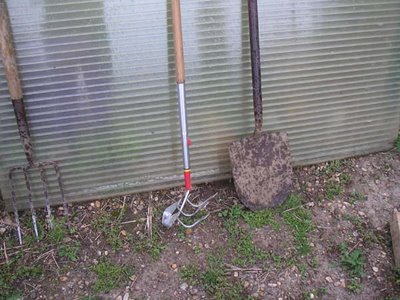 Iron hard ground full of stones calls for the right tools. Here's my Welsh miners pointed shovel with a steel shaft, and my Wolf hoe and weed loosener, a great tool.
Iron hard ground full of stones calls for the right tools. Here's my Welsh miners pointed shovel with a steel shaft, and my Wolf hoe and weed loosener, a great tool.
The plot costs me £12 a year, and for that you just get use of the plot and water (30 metres away), but nothing else. Fair enough really. Fencing and netting is an initial £100 outlay. The allotments are out in the country with fields and woods all around. Whilst you are toiling you can hear the larks singing constantly, the calls of South Oxfordshire's red kites wheeling overhead and pheasants screeching.
Heres some sweetcorn tomatoes and peppers. The Tomatoes are Marmande I got the seeds from France last year. Both the peppers and tomatoes are surplus plants to the real McCoy in our greenhouse at home. In our village we have a real old fashioned Ironmongers who sells great cheap plants too, the sweetcorn and courgette plants came from him. I brought a couple of screw eyes for a curtain from him the other day - 7p each instead of a packet at £4.50 from B&Q! Old fashioned customs, like splitting packets are often the best.

Note the stony ground. Afficionados remove them. I ignore them, why make work? They make a good mulch.
 Courgettes, Ridge Cucumbers and a little Butternut Squash plant. All on manure heaps. One day last year we had 14 cucumbers!
Courgettes, Ridge Cucumbers and a little Butternut Squash plant. All on manure heaps. One day last year we had 14 cucumbers!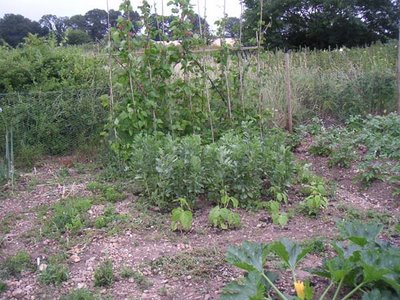 Runners French and Broad Beans. All on manure and mulched with more manure. When first planted out it was necessary to water these every evening. Since we are under hosepipe restrictions I had to do that by hand. Simultaneously I used the hose to fill the barrel. I don't believe in hosepipes because plants continuously watered with hoses don't grow decent root systems. As we only got 1 day of rain here in June I did water the beans every 3 to 5 days.
Runners French and Broad Beans. All on manure and mulched with more manure. When first planted out it was necessary to water these every evening. Since we are under hosepipe restrictions I had to do that by hand. Simultaneously I used the hose to fill the barrel. I don't believe in hosepipes because plants continuously watered with hoses don't grow decent root systems. As we only got 1 day of rain here in June I did water the beans every 3 to 5 days. 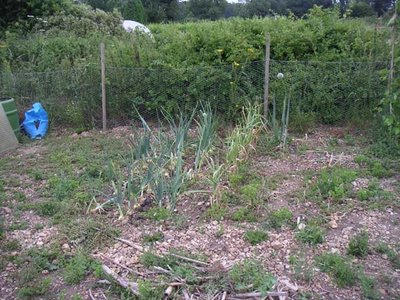 Onions, shallots and garlic do just great here.
Onions, shallots and garlic do just great here.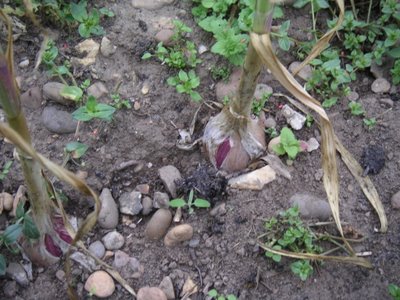 Here's a closeup of a 2 inch garlic bulb. I bought two bulbs for seed for 10p each from an Indian Grocer on Reading's Oxford Road and planted the cloves in early April. Almost ready....
Here's a closeup of a 2 inch garlic bulb. I bought two bulbs for seed for 10p each from an Indian Grocer on Reading's Oxford Road and planted the cloves in early April. Almost ready....
 The spuds, Arran Pilot, Foremost, Maris Peer and Desiree. I watered about the first three Arran Pilot's during the drought which resulted in a good initial crop. I have tried not earthing up a few Maris Peer and Desiree to see if this affects the yield. Why dig if you don't have to?
The spuds, Arran Pilot, Foremost, Maris Peer and Desiree. I watered about the first three Arran Pilot's during the drought which resulted in a good initial crop. I have tried not earthing up a few Maris Peer and Desiree to see if this affects the yield. Why dig if you don't have to?
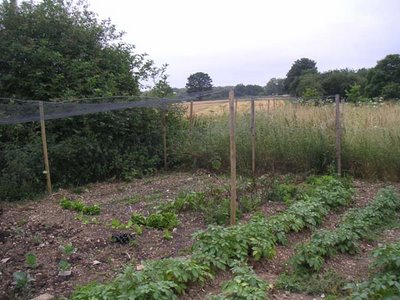 'The cage'. Necessary for any tasty crops. Therefore seed beds, strawberries, brassicae, lettuce and anything else tender goes in here. Last week I found two live pigeons in there. They ate all my baby cabbages, leaving the calibrese (choosy!), so I ate them. They tasted nice in a pie!
'The cage'. Necessary for any tasty crops. Therefore seed beds, strawberries, brassicae, lettuce and anything else tender goes in here. Last week I found two live pigeons in there. They ate all my baby cabbages, leaving the calibrese (choosy!), so I ate them. They tasted nice in a pie!

Heres the payoff, collected today. A couple of the first courgettes, some beetroot, shallots, runner beans and a root of Arran Pilot. This evening's dinner and fresh baby beets for tommorow's salad.
There are a lot of plots on our site free, covered in dense untended weeds. This can be explained by the natural obstacles I have described. As you can see mine is not the neatest plot in the world. I find that a couple of 1 1/2 hour sessions a week is all that is needed to grow what my pal Val and I need. There are some at our site that have the weed free regimented plots. However the vast majority are like mine, practical plots producing tasty vegetables in sub-optimum yields. There is no allotment committee, no allotment inspectors, no one enforcing any rules, and nature is your only companion.
It's perfect really.
2 comments:
Where I'm from courgettes are known as zucchini and natives lock their cars so farmers don't break in and leave them inside.
I leave my car unlocked, split any gifts down the middle and brush them with a little salad oil and grill them until charred and soft.
Hi Alan:
I loved seeing your garden. Made me feel as if I were there. Our garden is going well, too, though somewhat behind yours. We have lettuce and radish, as well as mint, lemon balm, sage, horseradish and thyme now. Soon to have beans, I hope, followed by the tropical things like tomatoes and eggplant (do you call it aubergine?).
Glad to see you're using your retirement wisely -- especially the sleeping late. Would love to see photos of and hear about your walking treks. Best to Val.
Stephanie
Post a Comment